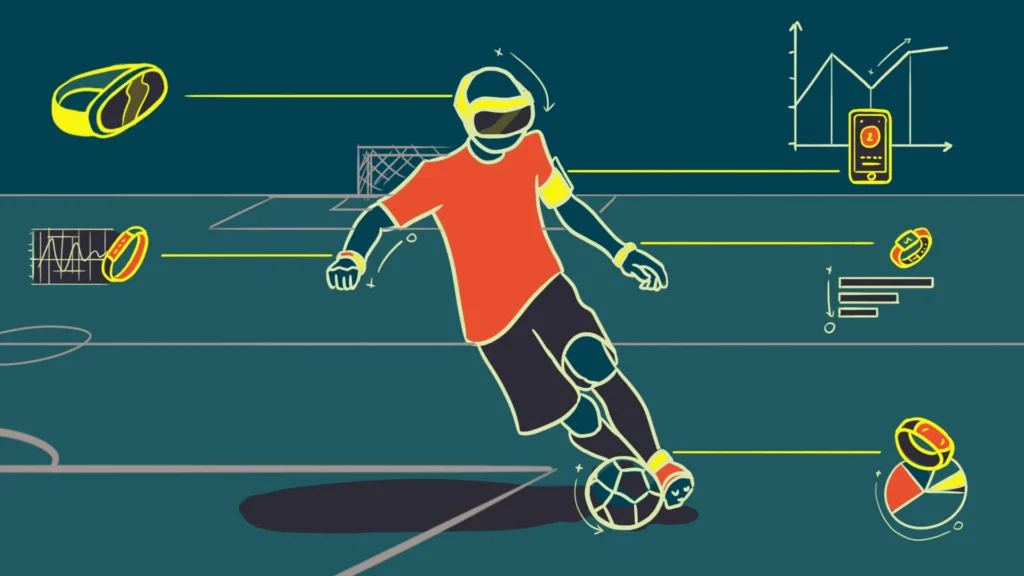
Our world was fully immersed in a technological landscape filled with an abundance of IoT in the Sports Industry and devices like Fitbits, smartwatches, VR goggles, smart TVs, PlayStations, advanced stadiums, and more in the year 2024. This shift has transformed diverse industries, and the sports industry is no exception. Whether you’re a fitness enthusiast, athlete, or sports fan, IoT devices have become an integral part of your life. Major sports brands including Under Armour, Adidas, and Asics have embraced this trend by developing their sports apps such as Runtastic and Edmondo.
How IoT Products Increase Their Shares in the Sports Industry
Colleges and sports organizations are conducting an astounding amount of research, experiments, and pilot projects on data and statistics. Prominent international sports leagues like the NFL, NBA, MLB, EPL, and F1 have invested their time and resources in integrating IoT into their daily functionalities.
Some remarkable research statistics on the market relevant to dedicated IoT developers are:
- The market size projection of smart sports equipment is a whopping 3.74 billion dollars if the CAGR is calculated at 8.2%.
- E-commerce alone has the potential to witness a rise of 7.4% CAGR between 2022 and 2030.
- The growth estimate for the remote health monitoring segment between 2022 and 2030 is expected to be above 12.8%.
Technology has successfully bridged the gap between ground-level sports essentials and the digital arena. The increased rate of cybersecurity in IoT has nurtured a sense of trust among day-to-day users. The overall notion of upcoming “smart stadiums” can be a real game-changing factor. Additionally, real-time data infused with faster connectivity will lead to more factual judgments, whether it’s for amateur fitness development or mass-level professional sports activities.
What IoT Products Are Covered in the Sports Industry?
The integration of the Internet of Things (IoT) in sports has revolutionized the way athletes train, compete, and fans engage with their favorite sports. In 2024, this trend has become pervasive, influencing various aspects of the sports industry.
Wearable Technology:
Athletes now commonly use wearable devices such as fitness trackers, smartwatches, and specialized sports gear equipped with sensors. These devices monitor vital metrics like heart rate, steps taken, distance covered, and even advanced performance data like speed, acceleration, and body movements. This data aids in personalized training programs and helps athletes optimize their performance.
Smart Equipment:
The emergence of smart sports equipment is reshaping training methodologies. Examples include smart basketballs, soccer balls, and cricket bats equipped with sensors to analyze ball trajectory, impact force, and player technique. This data is valuable for refining skills, making data-driven decisions, and preventing injuries.
Performance Tracking:
IoT is instrumental in real-time performance tracking during competitions. Sensors embedded in athletes’ clothing or equipment provide instant data on their movements and performance. This data not only enhances coaching strategies but also offers spectators a deeper understanding of the athletes’ abilities.
Smart Stadiums:
Modern stadiums are incorporating IoT technology to enhance the overall fan experience. From smart seating arrangements to connected concession stands and high-tech security systems, IoT creates a more immersive and secure environment for spectators. By hiring dedicated developers in the IoT sector, it is possible to control and supervise energy usage, light adjustments, and occupancies.
Fan Engagement:
IoT is transforming how fans interact with sports. Mobile apps and smart devices enable fans to access real-time statistics, immersive experiences, and even virtual reality content. This increased connectivity enhances the overall enjoyment of sporting events.
Injury Prevention and Health Monitoring:
Athlete well-being is a top priority, and IoT plays a crucial role in injury prevention and health monitoring. Wearables and embedded sensors help track an athlete’s physical condition, providing insights that can prevent overtraining and reduce the risk of injuries.
Data Analytics and Machine Learning:
The massive amount of data generated by IoT devices is analyzed using advanced analytics and machine learning algorithms. This enables teams and coaches to derive actionable insights, refine strategies, and make informed decisions based on performance trends.
Training Simulations:
Virtual Reality (VR) and Augmented Reality (AR) technologies, often integrated with IoT, are utilized for immersive training simulations. Athletes can experience real-game scenarios, enhancing their decision-making skills and situational awareness.
How IoT technology is improving optimization in sports
IoT technology is optimizing sports with wearable devices, sensors, and real-time data collection. Teams and organizations can use this technology to improve performance, prevent injuries, and enhance the fan experience. The answer to whether IoT technology is revolutionizing sports is a clear yes.
Real-time Performance Monitoring
IoT technology enables real-time performance monitoring during tournaments and game trials. Athletes can benefit from continuous observation of key metrics such as heart rate, distance, and speed. With remote access to this data, coaches can make timely adjustments to enhance performance. Studies have shown that athletes using IoT devices to calculate heart rate experienced a 7.5% reduction in recovery time during high-intensity training, leading to improved cardiovascular fitness strategies.
Custom Training
Digital feedback from IoT devices enables athletes to adjust training regimens, set goals, track progress, and make data-driven decisions to optimize their performance.
Quick Analysis
In the world of IoT app development services, IoT wearables and sensors collect a vast amount of data that can be used to perform comprehensive performance analysis. These devices generate algorithms that provide data-driven insights into important elements such as players’ techniques, energy levels, and movement patterns. This analysis helps to identify potential issues and improve daily routines.
On-Time Review
IoT wearable devices have revolutionized the way athletes train and perform. These devices provide real-time feedback on bodily reactions, techniques, and routines, enabling trainers to offer accurate guidance, implement improvements, and provide motivation to players. This data-driven approach leads to proactive player development and performance optimization both on and off the field.
According to a study on elite cyclists, the use of IoT-enabled power meters resulted in a 4.6% improvement in cycling performance over six months. Furthermore, GPS tracking in some wearables demonstrated a 12% increase in overall distances covered during matches compared to the previous year.
Conclusion
Smart stadiums have emerged as the latest trend, eclipsing the disruption in the sports industry in both physical and visual formats. The utilization of IoT app development services not only fosters the growth and evolution of this sector but also bolsters cybersecurity in IoT. Beyond this, it empowers trainers, sports companies, brands, and athletes to derive insights, make data-informed decisions, and optimize their statistics effectively.
In the realm of smart stadiums, this technological progression is fundamentally transforming how audiences experience sports programs. Whether it’s about witnessing live sports, amplifying fan engagement, or streamlining operations, IoT plays a pivotal role. The future of sports is interconnected, and IoT stands at the forefront of this thrilling transformation.
For those seeking to augment their IoT team with dedicated developers, Celestial Infosoft stands as a reliable partner. We leverage the potential of data to craft compelling, revolutionary, and efficient solutions and experiences to align with all your IoT objectives. Connect with us for a seamless tech journey.



Can you be more specific about the content of your article? After reading it, I still have some doubts. Hope you can help me.
Thank you for engaging with our blog post! We appreciate your feedback and would be happy to provide additional clarification on any specific points you’re unsure about. Please feel free to let us know which parts of the article you’d like more information on, and we’ll do our best to address your doubts. Your input helps us improve the quality of our content and ensure it meets your needs.
Your article helped me a lot, is there any more related content? Thanks!
Thank you for your sharing. I am worried that I lack creative ideas. It is your article that makes me full of hope. Thank you. But, I have a question, can you help me?
Thank you for your sharing. I am worried that I lack creative ideas. It is your article that makes me full of hope. Thank you. But, I have a question, can you help me?
Thanks for sharing. I read many of your blog posts, cool, your blog is very good.